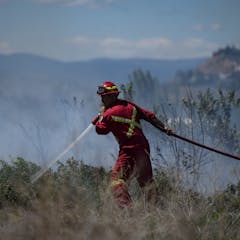
Articles on Floods
Displaying 1 - 20 of 409 articles

Massive damage to key infrastructure and croplands means the effects of Kenya’s devastating floods will be felt for a long time.

Too much pavement and old drainage systems are just two of the problems communities face.

In the lead-up to the 2024 federal budget, there was hope for investments in water management and water-related infrastructure. Those hopes were misplaced.

If accessible crisis information is not accurate, complete, up to date and high quality, there can be life and death consequences for people with disability in a bushfire, flood or pandemic.

Extreme downpours and droughts, both fueled by rising global temperatures, are taking a toll on water infrastructure. Communities trying to manage the threats face three big challenges.

You might be wondering: what is a ‘Black Nor'easter’, what’s causing all this rain and does it have anything to do with climate change? Here’s what you need to know.

Not all types of ground are the same and understanding how varied ground types react to environmental stresses is key to achieving true sustainability.

Despite improvements in disaster response management since the Abbotsford floods of 2021, long-term animal welfare remains woefully underappreciated in B.C.

Projections show that there’ll be Indian Ocean dipoles in the future – and that means more rainy days, and more extreme rainfall.

Public concerns for real estate value, and a focus on the self, make flood risk maps unpopular. However, these concerns should not dissuade governments from providing resources we can all trust.

Our expert in disaster recovery and climate change adaptation calls for a longer-term response to conflict zones affected by severe flooding, such as Libya and Pakistan.

Last year was the hottest in recorded history. That heat led to a range of unusually intense weather events across Australia.

A new study reveals that from 2050, Africa will suffer from food and water scarcity, and a massive loss of jobs in agriculture, unless climate change mitigation measures are put in place now.

Australians want government to act on climate change, but not necessarily now, or in their neighbourhood. How can governments resolve this dilemma?

Floodwaters pulsing into the sea normally clear within six days. But the 2022 floods in eastern Australia were different.

Whether it’s pamphlets aimed at prevention or text alerts, mass communication is often relied on during disasters. This flawed approach can be improved by engaging meaningfully with communities.

Cyclone Idai in Mozambique was an opportunity to test ideas about traits that help animals survive natural hazards.

On one stretch of Nottingham’s River Trent, floods that arrived every 50 years now return in ten.

An atmospheric scientist explains how rising temperatures are helping to fuel extreme storms, floods, droughts and devastating wildfires.

The North Queensland floods remind us of the need to build community resilience to disasters – during the event, in the immediate aftermath and beyond.
